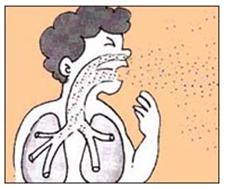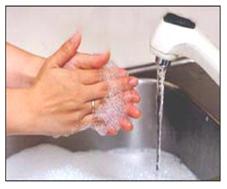에코바이러스 감염병, Echovirus infections (Echovirus infections)
에코바이러스 감염병의 원인
-
폴이오바이러스(Polioviruses), 에코바이러스(Echoviruses), 콕삭키바이러스(Coxsackieviruses), 엔테로바이러스(Enteroviruses) 이 네 종류의 바이러스 군을 통틀어 엔테로바이러스(Enteroviruses), 또는 장 바이러스라고 한다.
-
에코바이러스, A군 콕삭키바이러스와 B군 콕삭키바이러스, 또는 엔테로바이러스의 감염으로 생긴 바이러스 감염병을 통틀어 엔테로바이러스 감염병(Enterovirus Infections), 또는 비 폴리오바이러스 감염병(Nonpoliovirus infections)이라 한다.
-
에코바이러스에는 28 세분류 종이 있다.
-
콕삭키바이러스는 A군 콕삭키바이러스와 B군 콕삭키바이러스으로 나누어지고,
-
A군 콕삭키바이러스에는 23 세분류 종이 있고,
-
B군 콕삭키바이러스에는 6 세분류 종이 있고,
-
엔테로바이러스에는 61 세분류 종이 있다. 그 중 28 세분류 종의 에코바이러스 감염으로 생긴 에코바이러스 감염병에 관해 여기서 설명한다.
-
에코바이러스 감염병은 엔테로바이러스 감염병들 중 하나이다.
-
이 4종류의 엔테로바이러스 감염으로 인해 생긴 감염병의 증상 징후는 서로 비슷한 점이 많다.
다음은 최신 엔테로바이러스 새 분류입니다.
|
사람 엔테로바이러스 분류 (Classification of Human Enteroviruses)
|
|
|
군 (Family) |
피콜나비리대 (Picornaviridae) |
|
속 (Genus) |
엔테로바이러스(Enterovirus) |
|
서브구릅 (Subgroups) |
폴이오바이러스 혈청형 (1-3 Poliovirus serotype 1-3) |
|
콕삭키 A 바이러스 혈청형 1-22, 24 (Coxsackie A virus serotypes 1-22, 24) 23은 에코바이러스 9으로 재분류했다. |
|
|
콕삭키 B 바이러스 혈청형 1-6 (Coxsackie B virus serotypes 1-6) |
|
|
에코바이러스 혈청형 1-9, 11-27, 29-33 에코바이러스 혈청형 10과 28을 비 엔테로바이러스로 재분류했다. 에코바이러스 혈청형 34는 콕삭키 A 바이러스 혈청형 24로 재분류했다. 에코바이러스 혈청형 22와 23은 파에코바이러스(Parechovirus) 속으로 재분류했다. |
|
|
많은 엔테로바이러스 혈청형 72개 엔테로바이러스 혈청형을 A형 간염바이러스로 재분류했다. |
|
소스:Nelson Textbook of Pediatrics 19th ed 1088
에코바이러스 감염병의 감염경로

그림 3-81. 기침 할 때 나온 침이나 호흡기에서 나온 점액에 접촉될 때 각종 바이러스에 감염될 수 있다.
Copyright ⓒ 2012 John Sangwon Lee, MD., FAAP

사진 3-82. 바이러스가 오염된 가구를 접촉해도 각종 에코바이러스에 감염될 수 있다.
Copyright ⓒ 2012 John Sangwon Lee, MD., FAAP
-
항문–대변–입의 경로로 감염될 수도 있고
-
기침 할 때 나온 침이나 기도에서 나온 점액에 접촉될 때,
-
아기가 태어 날 때 부만 중 산도에서 에코바이러스에 감염된 후 신생아에게 에코바이러스 감염병이 생길 수 있다.
-
가구에 오염된 에코바이러스에 접촉될 때 에코바이러스에 감염될 수 있다.
-
연령을 가리지 소아청소년들이나 성인들에게도 감염될 수 있으나 소아청소년들은 에코바이러스에 가장 잘 감염된다.
-
위생시설이 불결하고 밀집 주거생활을 하거나 열대 지방에서 사는 빈곤층 소아들에게 더 잘 생긴다.
-
여름철과 가을철에 더 잘 생긴다.
-
에코바이러스 위장염을 앓다가 회복된 후 수 주 동안 에코바이러스가 대변으로 배출될 수 있고 에코바이러스는 습한 장소에서 약 1주 동안 감염성이 있다.
-
잠복기는 3~6일이다.
에코바이러스 감염병의 증상 징후
-
에코바이러스에 감염되면
-
결막염,
-
무균 뇌막염,
-
원인불명 열,
-
감기,
-
인두염,
-
헐판자이나(Herpangina/포진성 구협염/헤르팡기나),
-
설염,
-
폐렴,
-
흉막 통,
-
피부 발진,
-
뇌염,
-
신경마비,
-
구토 설사 복통,
-
간염,
-
출혈성 결막염,
-
심막염,
-
심근염,
-
수족구병 등이 생길 수 있다.
-
-
신생아에게 에코바이러스 감염병이 생기면 더 심하게 앓을 수 있다.
-
여름철에 흔히 있던 토사곽란이나 체했다고 하던 소화기계 병들의 원인이 아마도 에코바이러스 감염병 등이었을 것이다.
에코바이러스 감염병의 진단
-
병력, 증상 징후, 진찰소견 등을 종합해서 이 병을 진단하는 것이 보통이다.
-
PCR, VPI, RNA, IgM 검사 등으로 진단하기도 한다.
-
인두, 소변, 대변, 항문 등에서 얻은 피검 물로 에코바이러스 배양를 해서 확진할 수 있
에코바이러스 감염병의 치료
-
대증 치료 한다.
-
Pleconaril 항바이러스제로 치료할 수도 있다.
에코바이러스 감염병의 예방
-
예방접종 백신은 없다.
-
평소에 손을 깨끗이 씻어 이 병을 예방한다.
-
특히 이 병을 앓는 영유아에게 기저귀를 채울 때 손을 깨끗이 씻는다.
Echovirus infections
Causes of Ecovirus Infectious Diseases
• Polioviruses, Echoviruses, Coxsackieviruses, and Enteroviruses. These four groups of viruses are collectively referred to as enteroviruses or enteroviruses.
• Virus infections caused by infection with echovirus, group A coxsackievirus, group B coxsackievirus, or enterovirus are collectively called Enterovirus Infections or Nonpoliovirus infections.
• There are 28 subdivisions of echoviruses.
• Coxsackie virus is divided into group A coxsackie virus and group B coxsackie virus,
• Group A coxsackieviruses have 23 subclasses;
• Group B coxsackievirus has 6 subdivisions,
• There are 61 subclasses of enteroviruses. Among them, echoviral infectious diseases caused by echoviral infection of 28 sub-species are described here.
• Ecovirus infectious disease is one of enterovirus infectious diseases.
• Symptoms and signs of infectious diseases caused by these four types of enterovirus infection have many similarities.
The following is a new classification of enteroviruses.
|
Family
|
Picornaviridae |
|
Genus
|
Enterovirus |
| Subgroups |
Poliovirus serotype (1-3 Poliovirus serotype 1-3) |
|
Coxsackie A virus serotypes 1-22, 24 23 reclassified as Ecovirus 9. |
|
|
Coxsackie B virus serotypes 1-6 |
|
|
Echovirus serotypes 1-9, 11-27, 29-33 Ecovirus serotypes 10 and 28 were reclassified as non-enteroviruses. Echovirus serotype 34 was reclassified as Coxsackie A virus serotype 24. Echovirus serotypes 22 and 23 were reclassified into the genus Parechovirus. |
|
|
Many enterovirus serotypes 72 enterovirus serotypes were reclassified as hepatitis A virus. |
|
Source: Nelson Textbook of Pediatrics 19th ed 1088 Infection route of echovirus infectious disease

Figure 3-81. You can become infected with various viruses when you come in contact with saliva from coughing or mucus from the respiratory tract. Copyright ⓒ 2012 John Sangwon Lee, MD., FAAP

Picture 3-82. Even if you come into contact with furniture that is contaminated with the virus, you can become infected with various echoviruses. Copyright ⓒ 2012 John Sangwon Lee, MD., FAAP
• It can be transmitted through the anus-feces-mouth route.
• When in contact with saliva from coughing or mucus from the airways;
• Newborns can develop an echovirus infection after being infected with an echovirus in the birth canal during birth when the baby is born.
• You can become infected with an echovirus when you come in contact with a contaminated echovirus on your household.
• Children and adolescents of any age can also be infected, but children and adolescents are most susceptible to Echovirus.
• It is more likely to occur in poor children who have poor sanitation and live in densely populated or tropical regions.
• It is more likely to occur in summer and autumn.
• After recovering from echovirus gastroenteritis, the echovirus can be excreted in the feces for several weeks, and the echovirus is contagious in a humid place for about a week. • The incubation period is 3-6 days.
Symptoms Signs of Echovirus Infectious Disease
• If you are infected with an echovirus
o Conjunctivitis,
o Aseptic meningitis,
o Unexplained fever,
o cold,
o pharyngitis,
o Herpangina
o glossitis,
o Pneumonia;
o pleural pain,
o skin rash;
o Encephalitis,
o Nerve palsy;
o vomiting diarrhea abdominal pain;
o Hepatitis;
o hemorrhagic conjunctivitis,
o Pericarditis,
o myocarditis,
o Hand, foot and mouth disease may occur.
• Newborns can become more ill if they develop an Echovirus infection.
• The cause of digestive system diseases that were common in summer or vomit was probably caused by an Echovirus infection.
Diagnosis of Ecovirus Infectious Disease
• It is common to diagnose this disease by combining the medical history, symptoms, and examination findings.
• It is also diagnosed by PCR, VPI, RNA, and IgM tests.
• Confirmation can be confirmed by culturing echovirus with blood samples obtained from the pharynx, urine, feces, and anus.
Treatment of Echovirus Infectious Diseases
• Treat symptomatically.
• It can also be treated with Pleconaril antiviral drugs.
Prevention of Echovirus Infectious Diseases
• Vaccination
There is no vaccine available.
• Wash your hands regularly to prevent this disease.
• Wash hands thoroughly when changing diapers, especially for infants and toddlers with this disease.
출처 및 참조 문헌 Sources and references
- NelsonTextbook of Pediatrics 22ND Ed
- The Harriet Lane Handbook 22ND Ed
- Growth and development of the children
- Red Book 32nd Ed 2021-2024
- Neonatal Resuscitation, American Academy Pediatrics
- www.drleepediatrics.com 제1권 소아청소년 응급 의료
- www.drleepediatrics.com 제2권 소아청소년 예방
- www.drleepediatrics.com 제3권 소아청소년 성장 발육 육아
- www.drleepediatrics.com 제4권 모유,모유수유, 이유
- www.drleepediatrics.com 제5권 인공영양, 우유, 이유식, 비타민, 미네랄, 단백질, 탄수화물, 지방
- www.drleepediatrics.com 제6권 신생아 성장 발육 육아 질병
- www.drleepediatrics.com제7권 소아청소년 감염병
- www.drleepediatrics.com제8권 소아청소년 호흡기 질환
- www.drleepediatrics.com제9권 소아청소년 소화기 질환
- www.drleepediatrics.com제10권. 소아청소년 신장 비뇨 생식기 질환
- www.drleepediatrics.com제11권. 소아청소년 심장 혈관계 질환
- www.drleepediatrics.com제12권. 소아청소년 신경 정신 질환, 행동 수면 문제
- www.drleepediatrics.com제13권. 소아청소년 혈액, 림프, 종양 질환
- www.drleepediatrics.com제14권. 소아청소년 내분비, 유전, 염색체, 대사, 희귀병
- www.drleepediatrics.com제15권. 소아청소년 알레르기, 자가 면역질환
- www.drleepediatrics.com제16권. 소아청소년 정형외과 질환
- www.drleepediatrics.com제17권. 소아청소년 피부 질환
- www.drleepediatrics.com제18권. 소아청소년 이비인후(귀 코 인두 후두) 질환
- www.drleepediatrics.com제19권. 소아청소년 안과 (눈)질환
- www.drleepediatrics.com 제20권 소아청소년 이 (치아)질환
- www.drleepediatrics.com 제21권 소아청소년 가정 학교 간호
- www.drleepediatrics.com 제22권 아들 딸 이렇게 사랑해 키우세요
- www.drleepediatrics.com 제23권 사춘기 아이들의 성장 발육 질병
- www.drleepediatrics.com 제24권 소아청소년 성교육
- www.drleepediatrics.com 제25권 임신, 분만, 출산, 신생아 돌보기
- Red book 29th-31st edition 2021
- Nelson Text Book of Pediatrics 19th- 21st Edition
- The Johns Hopkins Hospital, The Harriet Lane Handbook, 22nd edition
- 응급환자관리 정담미디어
- Pediatric Nutritional Handbook American Academy of Pediatrics
- 소아가정간호백과–부모도 반의사가 되어야 한다, 이상원 저
- The pregnancy Bible. By Joan stone, MD. Keith Eddleman, MD
- Neonatology Jeffrey J. Pomerance, C. Joan Richardson
- Preparation for Birth. Beverly Savage and Dianna Smith
- 임신에서 신생아 돌보기까지. 이상원
- Breastfeeding. by Ruth Lawrence and Robert Lawrence
- Sources and references on Growth, Development, Cares, and Diseases of Newborn Infants
- Emergency Medical Service for Children, By Ross Lab. May 1989. p.10
- Emergency care, Harvey Grant and Robert Murray
- Emergency Care Transportation of Sick and Injured American Academy of Orthopaedic Surgeons
- Emergency Pediatrics A Guide to Ambulatory Care, Roger M. Barkin, Peter Rosen
- Quick Reference To Pediatric Emergencies, Delmer J. Pascoe, M.D., Moses Grossman, M.D. with 26 contributors
- Neonatal resuscitation Ameican academy of pediatrics
- Pediatric Nutritional Handbook American Academy of Pediatrics
- Pediatric Resuscitation Pediatric Clinics of North America, Stephen M. Schexnayder, M.D.
-
Pediatric Critical Care, Pediatric Clinics of North America, James P. Orlowski, M.D.
-
Preparation for Birth. Beverly Savage and Dianna Smith
-
Infectious disease of children, Saul Krugman, Samuel L Katz, Ann A.
- 제4권 모유, 모유수유, 이유 참조문헌 및 출처
- 제5권 인공영양, 우유, 이유, 비타민, 단백질, 지방 탄수 화물 참조문헌 및 출처
- 제6권 신생아 성장발육 양호 질병 참조문헌 및 출처
- 소아과학 대한교과서
Copyright ⓒ 2014 John Sangwon Lee, MD., FAAP
“부모도 반의사가 되어야 한다”-내용은 여러분들의 의사로부터 얻은 정보와 진료를 대신할 수 없습니다.
“The information contained in this publication should not be used as a substitute for the medical care and advice of your doctor. There may be variations in treatment that your doctor may recommend based on individual facts and circumstances.
“Parental education is the best medicine.